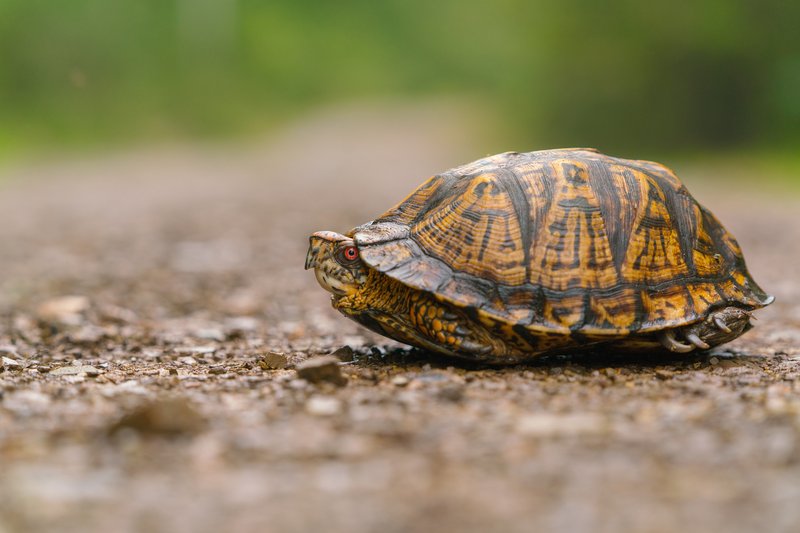
If you’ve ever found yourself curious about these little shelled creatures, you’re in for a treat. Box turtles have a lot of fascinating facts that could surprise you. From their remarkable habitats to their intriguing behaviors, there’s much more to them than meets the eye. Let’s dive in and explore the world of box turtles together!
1. What Exactly Is a Box Turtle?
Box turtles belong to the family Emydidae and are known for their distinctive, box-like shells. Unlike other turtles, their shells can completely close up. This feature isn’t just for decoration; it’s a clever defense mechanism against predators. Imagine having a protective shell that you can shut completely—pretty neat, right?
These turtles are generally divided into two main species: the Eastern box turtle and the Western box turtle. Depending on where you live, you might encounter different types of box turtles, each with its unique colors and patterns. The Eastern box turtle is often more vibrant, showcasing bright yellows and oranges. Meanwhile, the Western box turtle tends to have a more muted appearance.
So, the next time you spot a turtle, take a closer look. You might just be admiring a box turtle in all its glory!
2. The Lifespan of a Box Turtle
You might be surprised to learn that box turtles can live a really long time—often up to 50 years or more! Some even reach beyond their 100th birthday. That’s like having a pet that could outlast your car! Their longevity is partly due to their slow metabolism, which means they don’t need to eat as much as faster animals.
But how do they manage to thrive for so long? Generally, box turtles do well in environments that are stable and free from too many threats. If cared for properly, those little ones can become lifelong companions. However, much like our human friends, they need the right diet, habitat, and care to ensure they live a long, happy life.
Here’s the thing: if you’re considering adopting a box turtle as a pet, be prepared for a long commitment. It’s not just a short-term project!
3. Their Diet: What Do Box Turtles Eat?
Box turtles are omnivores, meaning they eat both plants and animals. Their diet can be quite varied and often includes:
- Fruits like strawberries and blueberries.
- Vegetables such as leafy greens and squashes.
- Insects like worms, crickets, and slugs.
Feeding them a balance of these foods helps keep them healthy and happy. Honestly, it’s kind of like preparing a well-rounded meal for yourself but with a turtle twist!
When in the wild, they tend to graze and forage, showcasing their curious nature. It’s fascinating to watch them explore their surroundings in search of food. If you have a box turtle at home, you can mimic this natural behavior by providing a variety of food items.
Just remember, some foods are not safe for them, so do your research before tossing anything in their direction!
4. Box Turtles and Their Habitat
Box turtles are generally found in environments with plenty of moisture and vegetation. This could be forests, grasslands, wetlands, or even suburban backyards—anything that gives them access to food and shelter. They love to dig and burrow and often make cozy homes in the soft soil.
Here’s the kicker: they don’t wander too far from their home base. Box turtles have a strong sense of direction and can navigate back to their original habitat even after being moved. Imagine getting lost somewhere and then finding your way home without a map!
This strong homing instinct is vital for their survival. Unfortunately, it makes them vulnerable to habitat loss due to urban development and farming. Protecting their natural environments is essential for ensuring they can continue to thrive.
5. Unique Shell Characteristics
The box turtle’s shell isn’t just for looks; it plays a crucial role in its life. A box turtle’s shell is made up of two parts—the upper carapace and the lower plastron. What makes the box turtle special is that the plastron has a hinge, allowing it to close itself completely. This ability is not common among turtles and serves as an impressive form of protection.
Each turtle’s shell pattern is unique, much like a human fingerprint. The patterns can vary widely, making each turtle a little piece of art! Pay close attention to their shells next time you spot one; you’ll notice that no two are exactly alike.
This unique shell structure also means these turtles can’t easily be flipped over, unlike some other turtle species. The strong hinge keeps them securely inside, which is a relief for both the turtle and the observing human.
6. Behavior and Social Structure
You might be wondering about how box turtles behave. These creatures are generally solitary. They aren’t the type to form big groups and prefer to spend their time exploring on their own. However, they can still be social in their ways. During mating season, males may engage in some head-bobbing and shell-bashing to attract females.
It’s interesting to note that box turtles have a level of intelligence that’s often overlooked. They can recognize their surroundings and remember locations of food or potential threats. This ability is essential for their survival in the wild.
When you see a box turtle, you might notice that they’re pretty slow-moving. This laid-back attitude is actually a part of their strategy. They take their time foraging, which helps them avoid attracting attention from predators. What a clever approach to life!
7. The Importance of Conservation
Box turtles face several threats in the wild, including habitat loss, pollution, and illegal collection for the pet trade. As their natural environments shrink, they struggle to find food and shelter, leading to declining populations.
Conservation efforts are crucial in protecting these fascinating creatures. Organizations work hard to preserve their habitats and educate the public about the importance of box turtles in ecosystems. Plus, there are many ways you can help! Simple actions like spreading awareness, supporting conservation groups, and even creating a friendly environment in your backyard can make a big difference.
By understanding and caring for box turtles, you’re not just helping a cute critter; you’re contributing to the overall health of our planet. Imagine a world where these little turtles can thrive without worry!
8. Myths and Misunderstandings
There are a lot of myths circling the box turtle world. For instance, some people think they can survive without water. The truth? Box turtles need water just like any other animal! They may not be swimmers, but they do require moisture to stay hydrated.
Another common misconception is that box turtles can live happily in captivity without proper care. In reality, keeping a box turtle as a pet means understanding their needs for habitat, diet, and social interaction. They’re not low-maintenance pets, even if they seem like it at first glance!
Let’s break the cycle of misinformation! Educating ourselves and others is essential in taking care of our wild friends. Next time you hear a myth about box turtles, you’ll be ready to set the record straight!
9. Fun Box Turtle Facts
Did you know that box turtles can actually breathe through their butts? Yes, you read that right! This unusual ability allows them to absorb oxygen from the water when submerged. It’s a survival tactic that comes in handy when they need to hide from predators.
Another fun fact is that some box turtles can change their color slightly based on their surroundings. They can darken or lighten to blend in better. This skill is useful when evading hawks and other aerial predators.
Lastly, box turtles are often considered a symbol of wisdom in many cultures due to their slow, thoughtful movements. They remind us to take life at our own pace and appreciate the little things.
10. What You Can Do to Help
Now that you know so much about box turtles, how can you help? First, always treat them with respect if you encounter one in the wild. Keep your distance and avoid picking them up unless they are in danger. If you do need to help them cross the road, move them in the direction they are heading — not back!
If you’re considering getting a box turtle as a pet, make sure to adopt from a reputable source. Supporting responsible breeders or rescue organizations ensures you’re not contributing to the decline of wild populations.
Lastly, getting involved with local conservation efforts can really amplify your impact. Whether it’s volunteering for habitat restoration or donating to turtle conservation organizations, every little bit helps.
Final Thoughts
Box turtles are genuinely fascinating creatures that deserve our respect and protection. With their unique adaptations and interesting behaviors, they offer us insight into the beauty of nature. Whether you see them in your backyard, at a pet store, or in the wild, remember their importance.
So the next time you hear about box turtles, you won’t just think of turtles in general. You’ll appreciate the magic of these little shelled wonders and what we can do to help them thrive for generations to come!

